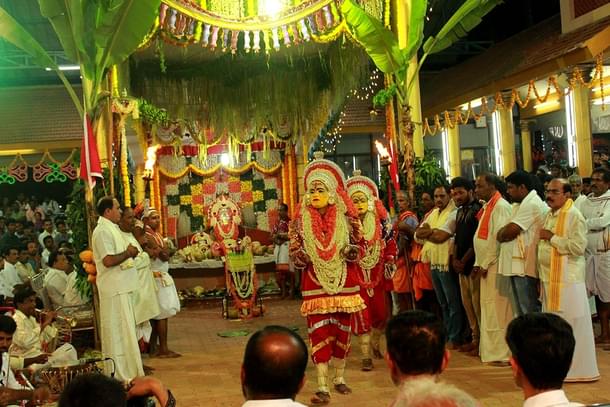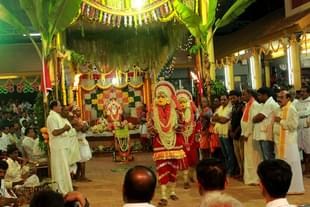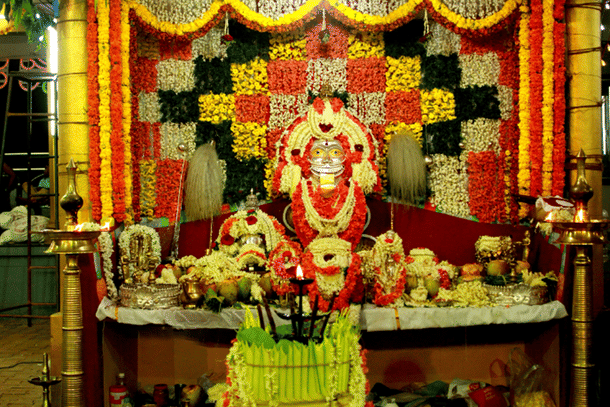Culture
No Controversy Here: Bhootaradhane Is Proudly And Undeniably Hindu
Harsha Bhat
Oct 19, 2022, 08:17 PM | Updated Oct 20, 2022, 11:32 AM IST
Save & read from anywhere!
Bookmark stories for easy access on any device or the Swarajya app.


‘Varaha roopam...daiva varishtam’ the lyrics of the song at the climax of Kantara has left a nation full of devouts, even the not-so-firm ones walking out of the theatre feeling a sense of divinity.
There is rarely anyone, no matter how distant or disconnected, from the land of Daivaradhane, that the film revolves around, who hasn’t been able to connect it to some form of folk cultural worship traditions in their own villages, or places that they come from.
Except for those of course, whose very intention is to belittle all things Hindu, that, much to their despair, may end up connecting all believers, irrespective of language, caste, creed and other divisions that they deviously time and again try to use as a weapon of ideological mass destruction.
And the latest attempt by the tribe of such ‘activists’ posing as actors among others is to call Daivaradhane or Bhoota Kola form of worship that is the central idea of the film as being non-Hindu.
And media outlets (which seem rattled by the reception the film has received) have carried a piece saying ‘Rishab Shetty has stirred a controversy’ by calling ‘Bhootas a part of Hindu tradition’.
Firstly, Rishabh Shetty has stated what is true for him and for all of us on the coast who believe in Daivaradhane. And if stating facts is stirring controversy, then the sun being a star should be the most controversial statement on the planet.
If there is anyone stirring controversy, it is those that want to do whatever it takes to portray it as ‘non-Hindu’.
It is not in the scope of an article to delve into the entire tradition of this worship, but here are some truths, that should be told, especially in counter to ‘views’ being peddled as facts.
And these are based on interactions with stakeholders and bearers of the tradition - whose very existence they owe to the ‘soil of the daivas’.
Firstly, so called ‘critics’ who are having an issue with the ‘Sanskrit’ lyrics of the song, should know that the lyrics have been penned to blend the classical with the folk, as has been a natural evolution of worship in the coast, atleast.
And neither condemns the other.
Also, using the word ‘varaha’ doesn't have to refer to the ‘wild boar’ avatar of Vishnu that goes by the same name. The lyrics DO NOT refer to Panjurli daiva as an incarnation of Vishnu.
The following line, also uses the adjective of ‘shiva dhootham’ - a messenger of Shiva. And I shall write about this later in this piece.
Conveniently, this ‘blunder’ that a certain social media user wishes whole of Tulunadu took offence to, is then backed by the assertion that are ‘distinct’ from the gods of ‘Brahminical Hinduism’.
Here’s a counter to that and other falsehoods being spread about Bhoota Kola and Daivaradhane:
1. Paaddaanas (folklore that is recited as form of worship that tells the tale of the daiva) are recorded in oral narratives, but so were most other tales of faith in this land.
We are a culture whose oral traditions had to resort to the written form only much later, and to this day, it is not the ‘written word’ but the tales handed over through lullabies and bhajans that are the foundation of faith for the larger populace.
Luv and Kush ‘told the tale’ of their father, that is the Ramayana.
2. ‘Bhootas are real people’- So was Rama and every other being worshipped as divine on this land.
They all took a human form, battled injustice, strived for the establishment of truth and attained divinity through it. “Daiva manusha roopena” is the nucleus.
3. Bhootas and daivas are worshipped daily, unlike what the writer wants you to believe. Their worship is not restricted to ‘annual ritual festivals’ nor is the daily pooja ‘conducted for the ritual objects, ornaments...’, as the writer has so casually passed off as a norm.
‘Poo neer’ or water and flower are offered daily, monthly worship is performed on every ‘sankramana or sankranti’ as per the solar calendar, and the Kola held as an annual affair.

Also in our culture, we do not look at ‘objects, ornaments’ that adorn our gods as ‘paraphernalia’ in the first place.
Anything that comes in touch with, or is possessed by or embodied by the divine, even for a moment, is seen as then possessing an ‘amsha’ or ‘essence’ of the divine and is worshipped as its bearer, until it be duly dissolved.
Speaking of Rishab Shetty’s interview, which according to the writer kicked up a row because he called Bhoota Kola a part of hindu culture, is one where he, with all clarity and conviction tackled questions.
He clarified that ‘the subtitle may have read so’ but it ‘Shiva sambhootham’ in that it is a demigod, a spirit that is then possessed by a person during the Bhoota Kola. And, in a language, he is not a native speaker of with almost native speaker like proficiency.
When the question about ‘Hindutva’ arises, he says ‘but this is our tradition right? Definitely it is Hindu culture, right.’
“As a Hindu, I have immense faith and pride in my culture, its practices. I wont say any other is wrong. But isn't the core concept of ‘God’ about that itself. That all distinctions, of ‘upper lower, this religion or that’ are to be gone beyond in front of such a force.
"When its about nature and humans, all coexist. Life itself is dharma. Daiva is a bridge to such a pursuit. So this is universal and true for all religions. But I have told this universal tale through our Hindu dharma, that's all,” says Rishabh Shetty, in the interview.
But his use of the word ‘Hindu’ seems to have irked those who want to make it about a certain ‘community’ or that it is an appropriation. It would do them well to know of the tale of Panjurli, the varaha or wild boar daiva, through its own paaddana.
To put it in brief (and foremost apologies to any overlook or errors), as inform locals, most daivas in their nudi at the outset say that it is in the ‘saarathya of naga birmer’ (led by Naga Birmer or Naga Brahma) that they carry out the task of dharma.
Abhilash Chowta, a local who is involved with the daiva worship rituals and an authority on such matters explained how the Panjurli paaddana itself narrates, how Panji kali and Panji kujjare seek Subraya’s (Tulu for Subramanya) intervention in the form of a ‘vara shapa’ (a curse that is a blessing) to let them, born as siblings, to have the ‘bhava’ of a couple so they can have a progeny.
The tale then goes on to describe the ‘bayake’ or baby shower of the ‘female boar’ and it giving birth to many young boars. Their mischief as they destruct fields around, has Esara Dever and Akke Sonne Parvati (Shiva and Parvati), a tribal folk form of Parvati, come to handle them.
Parvati ends up getting one little boar to her palace and pampering it, which then grows up and starts running havoc in Esara’s fields, who then shoots an arrow and kills it much to Parvati’s unhappiness.
As she gets sorrowful, Esara tells her that he will bring it to life and would depute the young boar to Tulunadu to uphold dharma. ‘Saiti panji jeeva aand’ (the dead boar thus came alive).
And then Esara pronounces ‘asura kulata panji puttd deva ganada bhoota aala’ (the boar that was born in the clan of asuras may you rise as a Bhoota with divine tendency) and send him to earth, with ‘sanjina kaddi and japada male’ (the sanjivani stick and chanting bead chain) in his hands.
And after pronouncing all his qualities and duties, Esara sends him to earth saying ‘Kaadud panji aadippu Naaadud daiva aad merela’ (you may have been a boar in the wild but move with honour as daiva among people).
But nuance is lost as usual on critics, who await opportunities to call Hindu way of life discriminatory and hail its differences.
Also, none of these though have lauded that Shetty has, without making any moral judgements, also shown how, until the 90’s, caste distinctions were very very evident, often discriminatory and exploitative too. For it doesn’t suit their narrative.
That it’s not ideology but something within the large fold of dharma, a tradition of worship, a bearer or possessor of the divine, rises in spirt and form to bring an end to the injustice around.
That it is ‘daiva’ which Shetty, even in his interview has said ‘is the hero of the film’, is what finally delivers justice, every single time that dharma is in danger.
Also Read: Kantara: Where Cinema Transcends Into A Spiritual Experience
Harsha Bhat is an author, linguist, content strategist, and a compulsive chronicler of Bharat's civilisational heartbeat.





